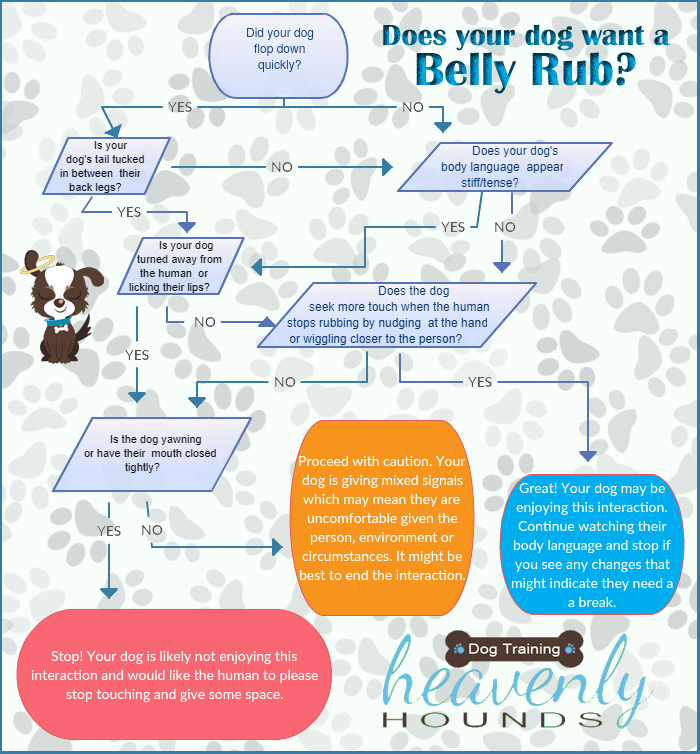Dogs love belly rubs, right? That’s what we all have been told. And it seems obvious when we see so many dogs flop onto their backs for us. The trouble is, that might not be what your dog is actually asking for. Let’s explore this tricky situation.
It is important to note that a dog would never flop onto their back and ask another dog to rub their belly. When we see a dog flop on their back in response to another dog, what is being communicated? Most experts agree that this exposure of the belly is what we call an appeasement gesture.
Let me give you a human example. If you encountered a stranger who was approaching you in an authoritative or hostile way (think: police officer or angry neighbor), you might throw your hands up in the air to show that you are unarmed, have no hostile intentions, and that you are not a threat. That is an appeasement gesture.
Dogs flopping onto their backs are communicating the exact same things by exposing their sensitive areas: groin, abdomen, and throat. What they are asking for with that gesture is for space and for the threatening party to cease and desist.
In many cases, then, it is reasonable to assume that when a dog flops over for a human, they are asking for the very same things! In dog body language, a dog leaning over another dog is a threat. With that in mind, it makes sense that a dog might become uncomfortable with attention from a human where the human is leaning over the dog and touching them. In order to communicate to the person, “hey, I’m not trying to harm you, please back off and give me space,” a dog might flip over onto their back. The trouble is that most humans assume this means the dog wants the petting to continue in the form of a belly rub.
Here is the tricky part: Some dogs genuinely love belly rubs. From the right person, in the right circumstances, many dogs can learn to love a good belly scratching. And that can lead to some serious conflict within the dog. If the dog is trying to communicate “move away, stop touching me” but then the belly rub does feel good, they can get all kinds of twisted up in their heads. A dog might enjoy the belly rub but then suddenly remember they are actually uncomfortable. This could result in a sudden lashing out with a bite to the human’s hand or even their face, if they are close enough (this is especially problematic with children who, by nature of their size, are going to be far closer to the dog’s chompers).
So, what is a dog owner to do? My advice is to learn to read your dog. Generally, I look at the speed of the “flop.” The faster the motion, the more likely the dog is trying to use their body language as an appeasement gesture. I also look at the circumstance. Does the dog do this as soon as a human approaches? If yes, it’s probably a “stop” signal. Does this dog do it suddenly in the middle of an interaction? If yes, again, it is probably a sign they are no longer comfortable. Often the best way to know if your dog is uncomfortable is to watch them when they are clearly happy and relaxed. How do they look in those moments? If you see your dog interacting with anyone and that body language is not consistent with their happy and relaxed display, it is probably best to end the interaction.
Check out the flow chart below to help you answer the question, “does your dog really want a belly rub?”

Happy Training!
Nicole L Yuhas CPDT-KA
This blog is intended to be informative as well as entertaining. It contains my opinion which may not reflect the opinions of any organization I may be affiliated with. My opinions should not be interpreted as those of my coworkers, family, friends, casual acquaintances, and certainly not the opinion of my cat, although my dog probably agrees with everything I say, if for no other reason, than because I provide the treats and meals (cats are less inclined to agree with anyone but themselves). Information provided here is accurate and true to the best of my knowledge but, as information and opinions change, neither the facts nor the opinions expressed here may be true or accurate at any future date. As I don’t currently own a time machine, I cannot be responsible for things that prove to be untrue, or opinions I change my mind about, should those changes become apparent in the future. It should also be noted that, as I am human, there may be omissions, errors or mistakes in the information provided here. Frankly, even if I were a computer, it is likely there would be errors, as computers, in my experience, can be a royal pain in the butt. This blog may contain affiliate links which you are under no obligation to click. If you click them, they will hopefully take you the place I intended. But they may not. As I’ve said, computers can be a pain. If you find yourself somewhere you don’t think I intended, click your ruby slippers three times together and say, “there is no place like home.” If you do that, and click the “back” button, you should be safely returned. Computers can, at times, have a mind of their own. Any training suggestions or opinions expressed here should be taken as information only and should not be seen as advice particular to you or your dog’s unique situation. Please consult with a training professional before taking any action.
